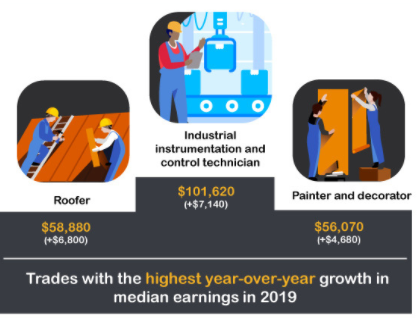Ontario Construction Report staff writer
Journeypersons had a median employment income of $60,450 in 2019, one year after certification, Statistics Canada reports. In the same year, the highest year-over-year growth in median earnings was in construction-related trades, such as industrial instrumentation and control technicians (+$7,140) and roofers (+$6,800).
Journeypersons were also less likely than ever before to move to another province or territory in 2019, one year after certification.
“Examining the employment income and mobility of journeypersons helps provide a better understanding of the economic environment of the trades in Canada,” StatsCan concluded in a report examining 2019 pre-pandemic earnings and mobility of journeypersons who certified in 2018.
Earnings of journeypersons during that period were highest in the territories ($83,700), Alberta ($74,870) and Saskatchewan ($68,390), while median earnings were lowest in Prince Edward Island ($45,790), Quebec ($52,430) and New Brunswick ($56,470).
Although western and northern Canada continued to lead the country, the gap narrowed from 2018, when the territories and all three western provinces experienced declines in median income.
Comparing first year median earnings of journeypersons who certified in 2018 with first year median earnings of journeypersons who certified the year prior, showed those in construction-related trades experienced the highest employment income growth.
Journeypersons who certified as powerline technicians ($118,580), crane operators ($102,560), and industrial instrumentation and control technicians ($101,620) in 2018 had the highest overall median earnings.
The report also found the number of female apprentices certified in higher earning trades such as carpenters (+0.7%), construction electricians (+0.4%) and industrial mechanics (+0.4%), may lead to higher employment income for female journeypersons in coming years.
Mobility declined in 2019, with just 5.6 per cent of journeypersons living or working in a province or territory other than their jurisdiction of certification – the lowest national mobility rate of journeypersons since 2008, and a 0.9% decline from the previous lowest rate in 2017.
Alberta continued to be a hub of interprovincial mobility for certified journeypersons. One year after certification, over one-fifth (21.9%) of journeypersons who either worked or lived in a province other than their province of certification had moved to Alberta. However, at the same time, over one-third (36.6%) of all journeypersons who left their province of certification came from Alberta.
“Alberta’s struggling economic environment led more journeypersons to migrate out of the province than into the province for the third consecutive year, likely to find employment. However, journeypersons who worked in Alberta one year after certifying experienced the highest median employment income ($74,870) of all provinces, though this was lower than what was seen in the territories,” the report concluded.
Statistics Canada’s next report will analyze earnings and mobility data for journeypersons in 2020, as the COVID-19 pandemic and corresponding disruptions began to take place and provinces and territories implemented guidelines, restrictions and lockdowns that greatly impacted the ability of Canadians to register, certify, and work in the trades.
Recently published data showed that new apprenticeship registrations were down by over one-quarter (-28.5%) in 2020, and certifications fell by almost one-third (-32.7%). It is anticipated that the impact of the pandemic on certifications in apprenticeship programs, along with the restrictions on many trade industries and travel during the year, will affect the earnings and mobility of journeypersons in 2020.

